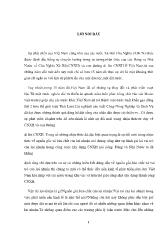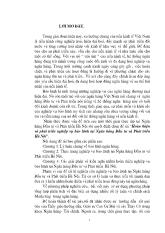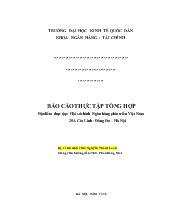An analysis of key changes in UCP 600 compared to UCP 500 and Recommendations for better application
- Người chia sẻ :
- Số trang : 91 trang
- Lượt xem : 11
- Lượt tải : 500
- Tất cả luận văn được sưu tầm từ nhiều nguồn, chúng tôi không chịu trách nhiệm bản quyền nếu bạn sử dụng vào mục đích thương mại
Bạn đang xem trước 20 trang tài liệu An analysis of key changes in UCP 600 compared to UCP 500 and Recommendations for better application, để xem tài liệu hoàn chỉnh bạn click vào nút DOWNLOAD LUẬN VĂN ở trên
1. Relevant of the study It is generally accepted that international trade transactions naturally carry more risks than domestic ones due to differences in practice, culture, business processes, laws and regulations. It is, therefore, important for traders to ensure that goods are dispatched and payment is made complying with the contract provisions. One effective solution for traders dealing with these risks has been documentary credit (D/C) or letter of credit (L/C). Despite of its complexity in compliance and high cost, L/C still enjoys popularity due to its safety with banks’ participation. It has been described as “the life blood of international commerce” (D’Arcy, Murray & Cleave 2000, p. 166) and the importance of L/C in trade transactions is evidenced by its global acceptance, with an estimated usage in excess of 1 trillion USD per annum (SITPRO Ltd, 2003). For more than 70 years, the International Chamber of Commerce ICC has formulated the so-called UCP-The Uniform Customs and Practice for Documentary Credits. The first attempt to codify letter of credit practice started in 1929 when ICC introduced its “Uniform Regulations and Commercial Documentary Credits”. Although the failure to gain wide acceptance, these rules provided a foundation for further developments. Then, in 1933, ICC issued “The Uniform Customs and Practice for Commercial Documentary Credits” and this set of rules received formal acceptance in more than 40 countries all over the world. It is, however, not until the issue of UCP in 1962, that global acceptance took place. Since then the rules has been regularly updated in 1974, 1983 (UCP 400), 1993 (UCP 500) and now we have the sixth Revision-UCP 600 which came into effect in July 2007. From the fact that the old revision-UCP 500 has reached a ten year cycle of usage and during its lifetime, it was proved to be more and more outdated, over-complicated and ambiguous which led to series of queries, commercial disputes, unjustified discrepancies leading to documentary rejections. Indeed, under ICC’s estimate, there is up to a 70% documentary non-compliance rate in letter of credit transactions (ICC Thailand, 2002). The new 2007 Revision, therefore, should be made to improve its certainty and clarity, reduce discrepancy problem and facilitate international trade activities using L/C product. 2. Aims of the study This study, “An analysis of key changes in UCP 600 compared to UCP 500 and Recommendations for better application”, aims to consider the differences from UCP 500 to UCP 600. The research questions posed in this study are: “Where the rules have been amended?” and “Which results in a potential changes in practice?”. Basing on the findings, this study will draw recommendations for parties involved in L/C transaction in applying the new revision UCP 600 before reaching the conclusion. 3. Research methodology The thesis relies on relevant literature, associated rules, articles, available statistics and employs method of comparison, analysis, arguments and synthesis. Data for the study was collected from various sources including reference books, magazines, articles, reports, new letters and the Internet. 4. Object and scope of the study Objects of the thesis are the two recent versions: UCP 500_1993 Revision and UCP 600 having commencement date of 1 July 2007. To have an in-depth understanding and appropriate application, associated rules that may have impact on these two revisions have been used as reference documents. 5. Structure of the study To achieve the above objectives, the study is divided into 3 chapters Chapter I: “Literature review”, provides an in-depth background that covers all theoretical issues relevant to UCP set of rules and documentary letter of credit. Chapter II: “Key changes under UCP 600 in comparison to UCP 500”, points out structural changes as well as key changes in UCP 600 in comparison with UCP 500. An evaluation of improvements and remaining problems is also discussed in this chapter. Chapter III: “Recommendations for better UCP 600 application”, based on the findings, the chapter will put an end to the study with recommendations for main parties involved in letter of credit transaction to suggest the best way in applying the new UCP 600.




